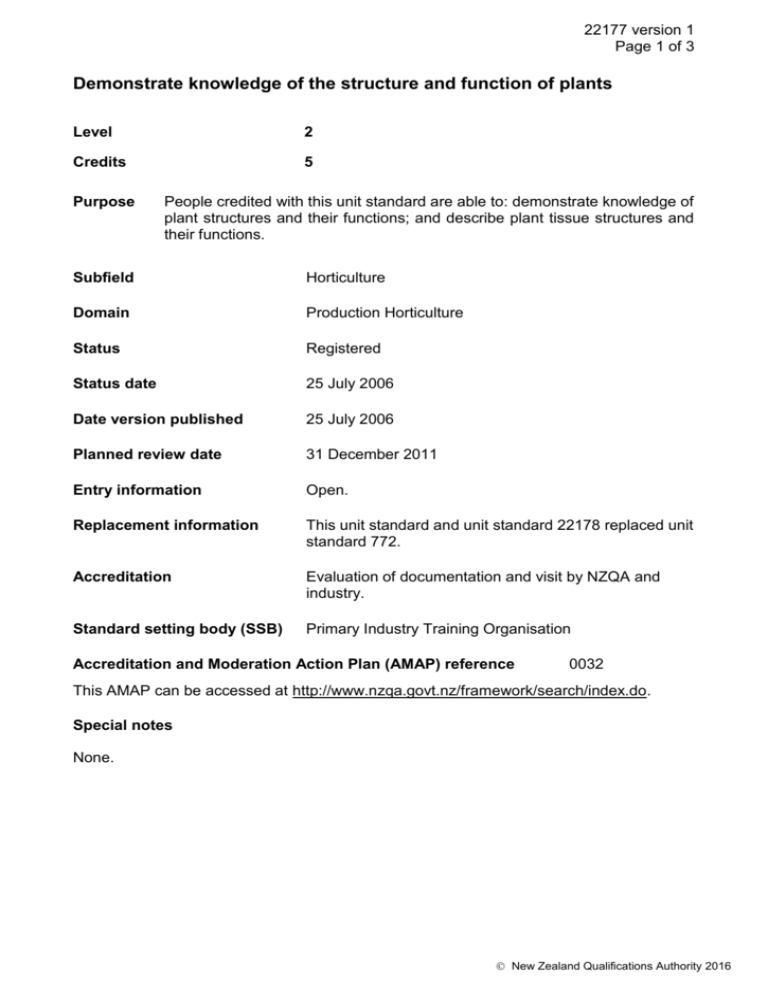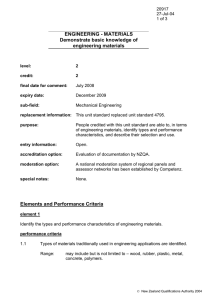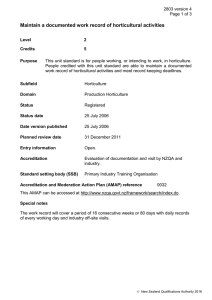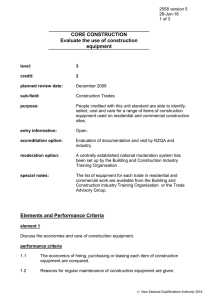Demonstrate knowledge of the structure and function of plants
advertisement

22177 version 1 Page 1 of 3 Demonstrate knowledge of the structure and function of plants Level 2 Credits 5 Purpose People credited with this unit standard are able to: demonstrate knowledge of plant structures and their functions; and describe plant tissue structures and their functions. Subfield Horticulture Domain Production Horticulture Status Registered Status date 25 July 2006 Date version published 25 July 2006 Planned review date 31 December 2011 Entry information Open. Replacement information This unit standard and unit standard 22178 replaced unit standard 772. Accreditation Evaluation of documentation and visit by NZQA and industry. Standard setting body (SSB) Primary Industry Training Organisation Accreditation and Moderation Action Plan (AMAP) reference 0032 This AMAP can be accessed at http://www.nzqa.govt.nz/framework/search/index.do. Special notes None. New Zealand Qualifications Authority 2016 22177 version 1 Page 2 of 3 Elements and performance criteria Element 1 Demonstrate knowledge of plant structures and their functions. Performance criteria 1.1 The cellular nature of plants is described in terms of cell structure, formation, and function. 1.2 Roots are described in terms of their structures and functions and importance to plant growth and stability. 1.3 Stems are described in terms of their structures and functions and importance to plant growth. 1.4 Leaves are described in terms of their structure and functions and importance to plant growth. 1.5 Flowers and fruits are described in terms of their structure and functions and importance to plant regeneration. Element 2 Describe plant tissue structures and their functions. Performance criteria 2.1 Vascular system and cambium tissue are described in terms of their importance to plant growth. Range root cambium, stem cambium, xylem, phloem. 2.2 Meristem tissue is described in terms of its importance to plant growth. 2.3 Epidermal tissue is described in terms of its importance to plant growth. 2.4 Storage tissue is described in terms of its importance to plant growth. Range 2.5 Internal and external plant signs are explained, recognised and used to identify the age of particular shoots. Range 2.6 stem and root tubers, corms, bulbs, roots. lateral growth rings, external rings on shoots. Fruit buds and vegetative buds are identified and defined in terms of their significance at pruning time and for propagation. New Zealand Qualifications Authority 2016 22177 version 1 Page 3 of 3 Please note Providers must be accredited by the Qualifications Authority, or an inter-institutional body with delegated authority for quality assurance, before they can report credits from assessment against unit standards or deliver courses of study leading to that assessment. Industry Training Organisations must be accredited by the Qualifications Authority before they can register credits from assessment against unit standards. Accredited providers and Industry Training Organisations assessing against unit standards must engage with the moderation system that applies to those standards. Accreditation requirements and an outline of the moderation system that applies to this standard are outlined in the Accreditation and Moderation Action Plan (AMAP). The AMAP also includes useful information about special requirements for organisations wishing to develop education and training programmes, such as minimum qualifications for tutors and assessors, and special resource requirements. Comments on this unit standard Please contact the Primary Industry Training Organisation via their website www.primaryito.ac.nz if you wish to suggest changes to the content of this unit standard. New Zealand Qualifications Authority 2016











